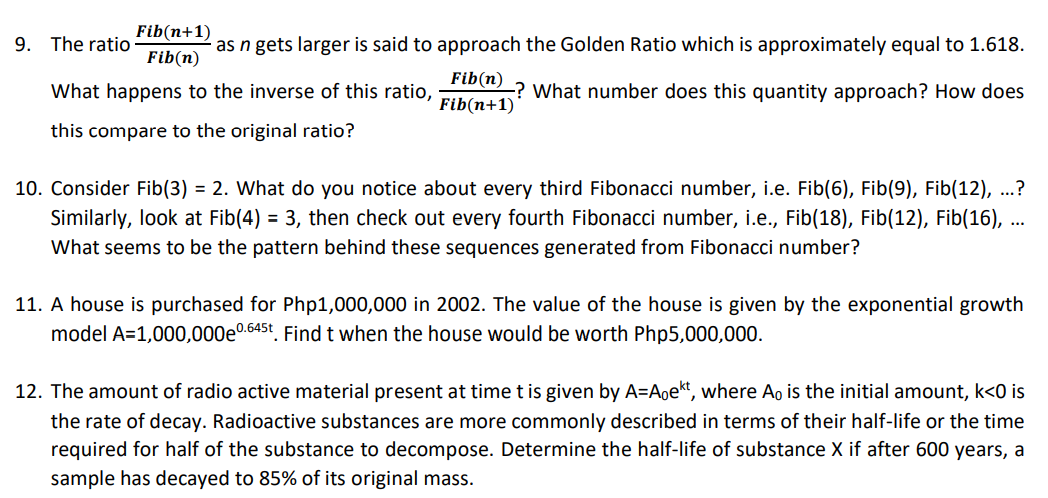The amount of radio active material present at time t is given by A=Aoe*t, where Ao is the initial amount, k<0 is the rate of decay. Radioactive substances are more commonly described in terms of their half-life or the time required for half of the substance to decompose. Determine the half-life of substance X if after 600 years, a sample has decayed to 85% of its original mass.
The amount of radio active material present at time t is given by A=Aoe*t, where Ao is the initial amount, k<0 is the rate of decay. Radioactive substances are more commonly described in terms of their half-life or the time required for half of the substance to decompose. Determine the half-life of substance X if after 600 years, a sample has decayed to 85% of its original mass.
Algebra: Structure And Method, Book 1
(REV)00th Edition
ISBN:9780395977224
Author:Richard G. Brown, Mary P. Dolciani, Robert H. Sorgenfrey, William L. Cole
Publisher:Richard G. Brown, Mary P. Dolciani, Robert H. Sorgenfrey, William L. Cole
Chapter7: Applying Fractions
Section7.1: Ratios
Problem 25WE
Related questions
Question

Transcribed Image Text:Fib(n+1)
9. The ratio
as n gets larger is said to approach the Golden Ratio which is approximately equal to 1.618.
Fib(n)
Fib(n)
What happens to the inverse of this ratio,
-? What number does this quantity approach? How does
Fib(n+1)
this compare to the original ratio?
10. Consider Fib(3) = 2. What do you notice about every third Fibonacci number, i.e. Fib(6), Fib(9), Fib(12), ...?
Similarly, look at Fib(4) = 3, then check out every fourth Fibonacci number, i.e., Fib(18), Fib(12), Fib(16), ..
What seems to be the pattern behind these sequences generated from Fibonacci number?
11. A house is purchased for Php1,000,000 in 2002. The value of the house is given by the exponential growth
model A=1,000,000e0.645t. Find t when the house would be worth Php5,000,000.
12. The amount of radio active material present at time t is given by A=Aoekt, where Ao is the initial amount, k<0 is
the rate of decay. Radioactive substances are more commonly described in terms of their half-life or the time
required for half of the substance to decompose. Determine the half-life of substance X if after 600 years, a
sample has decayed to 85% of its original mass.
Expert Solution
This question has been solved!
Explore an expertly crafted, step-by-step solution for a thorough understanding of key concepts.
Step by step
Solved in 2 steps

Knowledge Booster
Learn more about
Need a deep-dive on the concept behind this application? Look no further. Learn more about this topic, advanced-math and related others by exploring similar questions and additional content below.Recommended textbooks for you

Algebra: Structure And Method, Book 1
Algebra
ISBN:
9780395977224
Author:
Richard G. Brown, Mary P. Dolciani, Robert H. Sorgenfrey, William L. Cole
Publisher:
McDougal Littell

College Algebra (MindTap Course List)
Algebra
ISBN:
9781305652231
Author:
R. David Gustafson, Jeff Hughes
Publisher:
Cengage Learning

Algebra & Trigonometry with Analytic Geometry
Algebra
ISBN:
9781133382119
Author:
Swokowski
Publisher:
Cengage

Algebra: Structure And Method, Book 1
Algebra
ISBN:
9780395977224
Author:
Richard G. Brown, Mary P. Dolciani, Robert H. Sorgenfrey, William L. Cole
Publisher:
McDougal Littell

College Algebra (MindTap Course List)
Algebra
ISBN:
9781305652231
Author:
R. David Gustafson, Jeff Hughes
Publisher:
Cengage Learning

Algebra & Trigonometry with Analytic Geometry
Algebra
ISBN:
9781133382119
Author:
Swokowski
Publisher:
Cengage